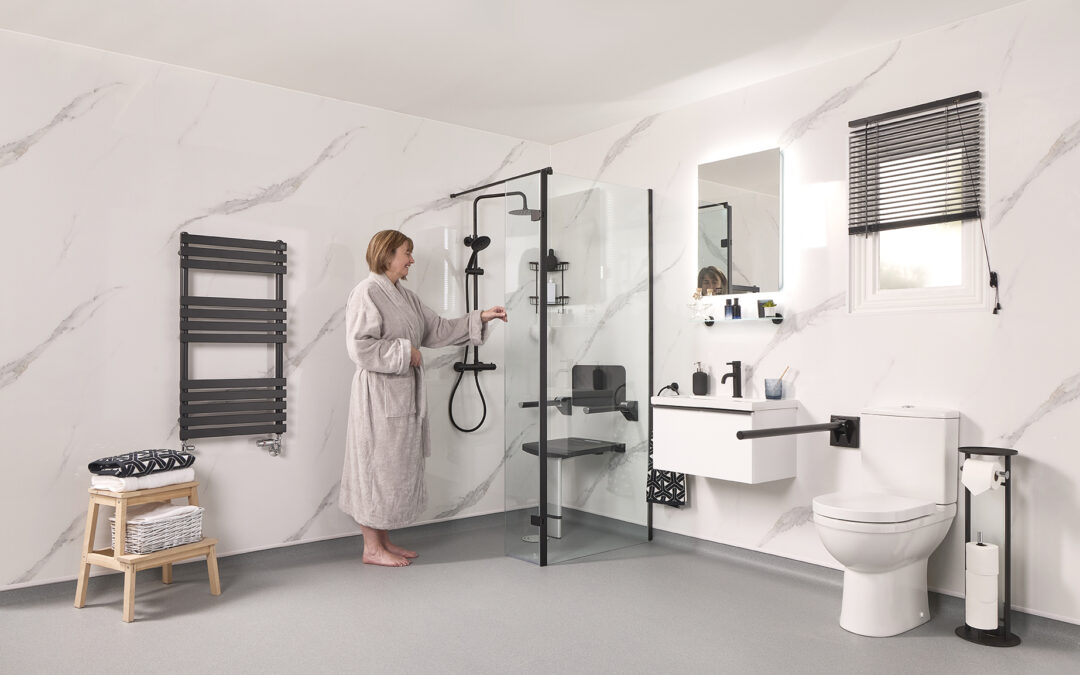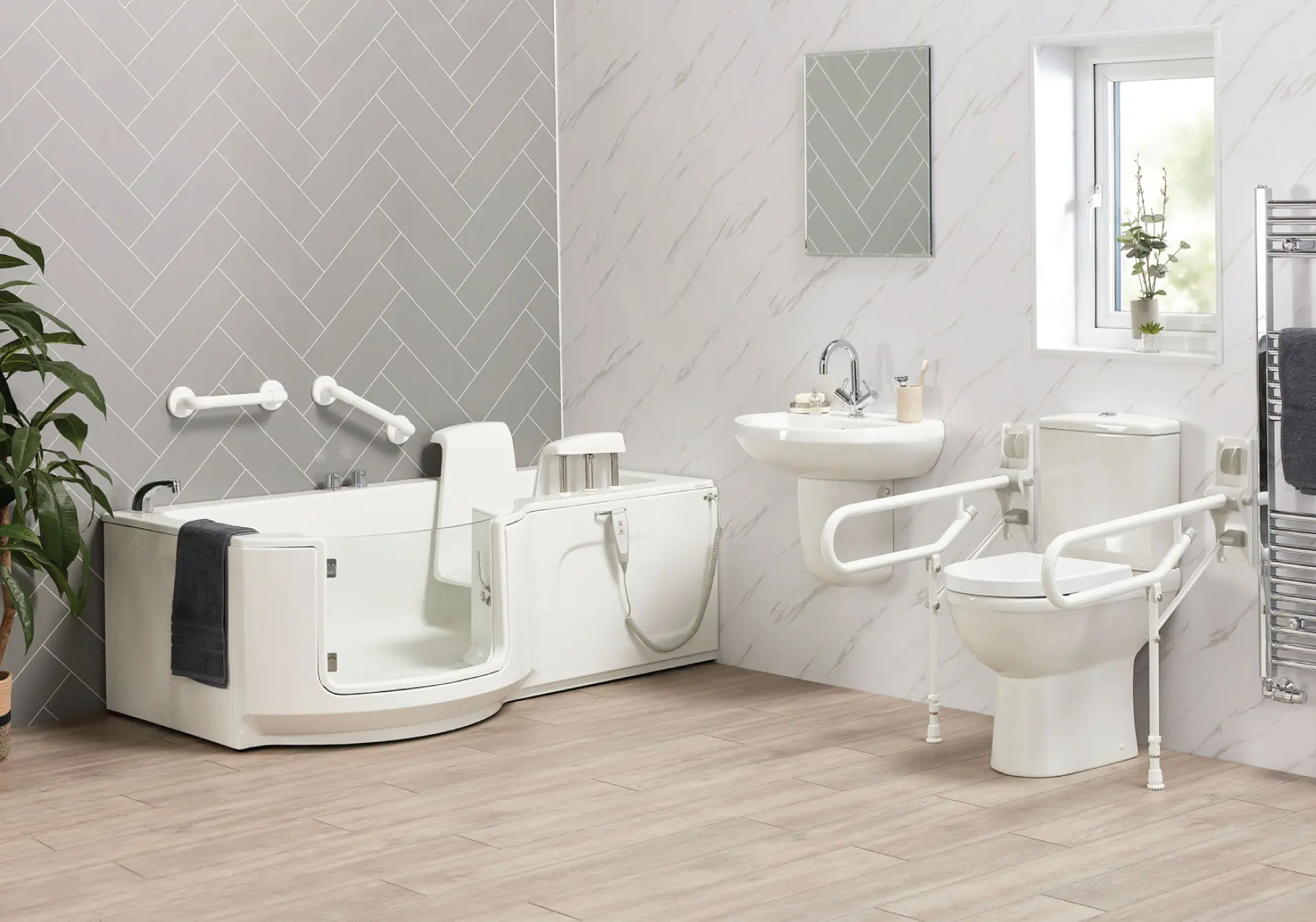Table of Contents
- 1) Core safety features
- 2) Wheelchair-friendly layout
- 3) Easy-use fixtures (taps, controls & accessories)
- 4) Storage solutions (safe reach = daily independence)
- 5) Visual & lighting adaptations
- 6) Future-proofing for aging in place
- At-a-glance spec (print or save)
- Affordable upgrades vs bigger changes
- Daily habits that keep it safe
- Safety checklist (copy-paste or print)
- FAQs
An accessible bathroom prioritises level access, wet-rated anti-slip flooring (PTV ≥36), grab rails at key points, a fold-down shower seat, easy-use controls, good lighting/contrast, zero-threshold doorways, and clear manoeuvring space for mobility aids or a wheelchair. Add smart storage at reachable heights and future-proofing (blocking for rails, flexible layouts) so the room adapts as needs change.
1) Core safety features
Must-haves (that actually prevent falls & scalds)
-
Level access throughout (no internal steps; flush shower entry).
-
Wet-rated anti-slip surface on floors (PTV ≥36) and a textured shower tray or wet-room floor.
-
Grab rails at entry, seat, and exit points; fixed into structure (not suction).
-
Fold-down shower seat set to a comfortable height; controls reachable while seated.
-
Thermostatic mixing valve (TMV) to limit hot water temperatures and prevent scalds.
-
Drainage done right (consistent falls to drain; no pooling).
-
Even, bright lighting (with a night-light route for nocturnal visits).
Nice-to-haves
-
Warm-touch rails; anti-fog mirror; slip-resistant bath mat outside the wet zone only if secured.
Tip: Safety spec > product label. A well-specified level-access shower is usually safer than a poorly-specified “accessible” bath.
2) Wheelchair-friendly layout
Design for space, flow, and transfers:
-
Manoeuvring room: allow generous clear floor space so a wheelchair or walker can approach the WC, basin and shower without tight turns.
-
Approach & transfer zones: keep unobstructed space beside the WC and at the shower seat for lateral/sit-to-stand transfers.
-
Zero-threshold doorways: avoid internal thresholds; consider out-swing or pocket doors to free floor area.
-
Screens that swing/fold: choose shower screens/curtains that open wide to make space for carers and equipment.
-
Reach ranges: place taps, controls, storage and switches within easy forward/side reach from seated and standing positions.
Tip: If a carer helps, mock up the movement path with a chair or rollator before you commit the layout.
3) Easy-use fixtures (taps, controls & accessories)
-
Lever or push controls (single-lever mixers are ideal); avoid small, fiddly knobs.
-
Thermostatic shower with a clear max-temp limiter and tactile/visual indicators.
-
Hand-held shower on a sliding rail; mount so it can be reached from the seat and the entry.
-
Comfort-height WC (or riser) with space for rails both sides; soft-close seat/lid.
-
Basins with knee clearance and shallow fronts to bring the user closer; offset waste to avoid knee clash.
-
Door & cabinet hardware: D-pulls or large grips; avoid tiny handles.
4) Storage solutions (safe reach = daily independence)
-
Primary storage between shoulder and hip height from both standing and seated positions.
-
Wet-zone storage (niche/shelf) inside the shower within arm’s reach of the seat.
-
Avoid bending/twisting: no essentials in low/back corners; use pull-outs and open shelving.
-
Tidy cables & kit: stow leads for shavers/dryers; keep floors clear to prevent trips.
5) Visual & lighting adaptations
-
High contrast between floors, walls, rails and the seat improves edge detection.
-
Even, diffuse lighting (avoid glare); add a night-light path from bed → bathroom.
-
Task lighting at the mirror/basin with anti-fog mirror heaters if needed.
-
Non-distracting patterns: busy floor tiles can disorient; choose calm textures with clear visual boundaries.
6) Future-proofing for aging in place
-
Wall blocking/reinforcement behind tiles so more rails can be added later.
-
Modular showering: rails/seat that can move positions; adjustable height.
-
Flexible services: leave access to traps and isolation valves; design for maintenance without demolition.
-
Scalable layout: keep wide approaches and clearances so the room still works if a wheelchair or carer becomes necessary.
At-a-glance spec (print or save)
| Area | Practical spec (user-centred) |
|---|---|
| Floor safety | Wet-rated anti-slip (target PTV ≥36); consistent falls to drain |
| Shower entry | Level access (flush threshold) |
| Seating | Fold-down seat; controls reachable while seated |
| Grab rails | Fixed at entry/seat/exit; into structure; warm-touch preferred |
| Controls | Lever/push; clear temp markers; TMV scald protection |
| Lighting | Even, bright; add night-light; avoid glare |
| Storage | Shoulder–hip height; inside-shower niche within seated reach |
| Layout | Clear approach to WC/basin/shower; wide screen opening for assistance |
Affordable upgrades vs bigger changes
| Your challenge | Low-disruption upgrade | Bigger change when needed |
|---|---|---|
| Slips/falls in shower | Add PTV ≥36 anti-slip, fold-down seat, rails | Convert to level-access shower or fully tanked wet area |
| Hard to reach taps | Swap to lever mixers with TMV | Re-plumb with thermostatic valves and new controls |
| Cramped transfers | Change screen/curtain to open wider; relocate storage | Re-plan layout; consider out-swing door / pocket door |
| Night-time risks | Night-light, declutter routes | Re-light the room; higher-contrast finishes |
| Carer assistance | Add rails both sides; hand-held shower | Wider shower zone with open access and carer space |
Daily habits that keep it safe
-
Dry floors right away (keep a squeegee handy).
-
De-clutter routes; remove loose mats and trailing leads.
-
Clean surfaces regularly — soap residue reduces grip.
-
Review setup after any health or mobility change.
Safety checklist (copy-paste or print)
-
Level-access shower entry (flush threshold)
-
Wet-rated anti-slip floor (target PTV ≥ 36)
-
Fold-down shower seat (comfortable height)
-
Grab rails at entry, seat and exit points (fixed into structure)
-
Lever/push controls with a thermostatic mixing valve
-
Hand-held shower reachable from the entry and from the seat
-
Even, bright lighting with a night-light route
-
Clear approach space to WC, basin and shower
-
Storage at shoulder–hip height; niche within seated reach
-
Drainage falls correct with no pooling after use
-
Wall blocking in place for future rails/adaptations
FAQs
What floor finish is safest in a bathroom?
A wet-rated anti-slip surface that achieves PTV ≥36 in wet conditions, kept clean so the texture works as designed.
Do I need a fan if there’s a window?
Yes. A quiet mechanical extract (plus an airflow path like an under-cut door) keeps moisture down, protects finishes and helps the floor stay grippy.
Is a walk-in bath accessible?
It removes the high step, but fill/drain time can be a consideration. For many users, a level-access shower with seat and rails is the simplest, lowest-maintenance option.












